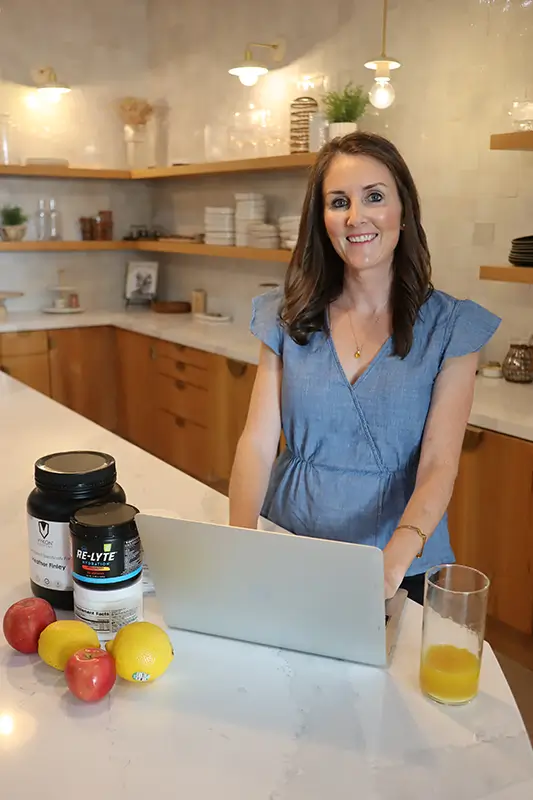You’ve taken the antibiotics. Maybe you followed a low FODMAP diet or a strict protocol. And for a couple of weeks, it seemed like things were finally better. But then…the bloating returned. The constipation crept back in. Your stomach started reacting to meals again, and you began wondering if the treatment even worked at all. If you’re stuck dealing with SIBO (small intestinal bacterial overgrowth) after antibiotics, you’re not alone, and it doesn’t mean your gut is broken or that you will have to deal with SIBO forever. It means something deeper hasn’t been addressed. In Part 1 of this SIBO series, we talked about what SIBO actually is (and isn’t). In this post, we’ll dig deeper into why symptoms often return after treatment, and what to do instead.
Why You Still Feel Awful After SIBO Treatment
When SIBO symptoms come back after antibiotics, it’s easy to feel defeated. Many women find themselves stuck in a loop: test, treat, repeat with little to no lasting relief. The real issue? SIBO is rarely the root cause. It’s a downstream effect of deeper dysfunction in the gut, and unless those upstream imbalances are addressed, the overgrowth tends to return. Let’s unpack what those imbalances are and what to do instead of heading straight into another round of treatment.
Why SIBO Is a Symptom, Not the Root Cause
Most people are taught to treat SIBO like the end diagnosis. Take the right medication or supplement combo, and it should go away. But SIBO is actually a symptom and a red flag that something upstream in your digestion isn’t working the way it should. That’s why we see so many women whose symptoms come back within weeks of treatment.
Some of them have taken antibiotics four, five, even six times. Others have been told they’ll need to stay on antimicrobials indefinitely, almost like a maintenance plan, because “this might just be your normal.” And that’s not just physically exhausting. It’s emotionally draining. You go through a protocol, change your diet, follow all the steps, and start to feel hopeful. Then the bloating creeps back in. The fatigue returns. And you’re right back on the SIBO roller coaster: more protocols, more money, more meals that leave you feeling awful.
It’s defeating to keep doing what you’re told is “the right approach,” only to get the same disappointing results. But the real problem isn’t that your gut is broken: it’s that the deeper root causes have never been addressed. Antibiotics might temporarily reduce the overgrowth, but unless you fix the reason your gut became vulnerable in the first place, it’s just a matter of time before it returns. You don’t need to stay stuck in the cycle. You need a new strategy and one that focuses on restoring the terrain, not just wiping out bacteria.
Common Terrain Imbalances That Keep SIBO Coming Back
Low Stomach Acid & H. pylori
Stomach acid isn’t just for breaking down food, it’s your first line of defense. It sterilizes what you eat, signals the release of enzymes, and keeps bacteria from migrating where they don’t belong. When stomach acid is low, food sits in the stomach longer and begins to ferment, especially carbohydrates. This not only creates pressure and bloating but also allows bacteria to thrive in places they shouldn’t, like your small intestine.
One of the most common culprits behind low stomach acid is H. pylori, a bacterial infection that often goes undetected on standard testing. It suppresses acid production and kicks off a cascade of digestive dysfunction: poor breakdown of proteins, sluggish motility, and the perfect environment for SIBO to return. We see this all the time: clients with “normal” scopes or biopsies who are still dealing with persistent bloating and reflux, only to find H. pylori on a stool test. If you’ve treated SIBO multiple times and it keeps coming back, this is one of the first upstream pieces to investigate.
Gallbladder Issues and Sluggish Bile Flow
The gallbladder plays a far bigger role in digestion than most people realize. Its job is to store and release bile: a bitter fluid made by the liver that emulsifies fat, supports nutrient absorption, and acts as a natural antimicrobial in the small intestine. When bile flow is sluggish, thick, or missing altogether (like after gallbladder removal), digestion becomes compromised. Fat doesn’t break down properly, which often shows up as sticky or floating stools, and bloating after meals, especially meals that contain higher amounts of fat.
Without that antimicrobial bile flow coating the small intestine, bacteria are free to settle in and multiply (leading to SIBO). Research shows people without a gallbladder are up to 10 times more likely to develop SIBO. That doesn’t mean it’s inevitable, it just means you have to intentionally support bile flow through diet, lifestyle, and targeted supplements like bitters, taurine, or ox bile (if needed). This step is often skipped in SIBO protocols but makes a huge difference in preventing recurrence.
Constipation and Pelvic Floor Dysfunction
Slow motility is one of the biggest risk factors for SIBO, yet it’s often ignored. If you’re not having daily, complete bowel movements, stool and bacteria sit longer in the gut, which gives bacteria the time and space to overgrow. Many women chalk up constipation to “not drinking enough water” or “not eating enough fiber,” but often the root issue lies deeper, especially in the pelvic floor.
The pelvic floor muscles help coordinate evacuation. If those muscles are too tight, weak, or uncoordinated (which can happen from chronic straining, stress, childbirth, or even long-distance running), you’ll struggle to fully empty your bowels. This creates the perfect environment for SIBO to return. No amount of antimicrobials can fix a stuck pelvic floor. That’s why pelvic floor physical therapy is one of the most overlooked, but most effective referrals we make for women who’ve done “everything” for their gut and still feel bloated and backed up.
Mineral Depletion and Nervous System Stress
Minerals like sodium, potassium, and magnesium are not just about hydration: they’re electrical conductors that power digestion, motility, enzyme function, and nervous system regulation. When these minerals are low (which is extremely common in women with gut issues, stress, or a history of restrictive dieting), the gut simply can’t function well. Motility slows down. Enzyme production drops. And the nervous system shifts into fight-or-flight mode, making digestion even harder.
We often say that these minerals are the “spark plugs” of the digestive system. Without them, it’s like trying to run a car with a dead battery: you can push all the buttons, but nothing’s going to start. This is why mineral testing, especially HTMA, is so powerful for our clients. It shows us whether the gut has the capacity to heal and helps us restore the energy systems that keep digestion moving. If you’ve taken antibiotics for SIBO and still feel wired, tired, bloated, and stuck, it’s time to look at what your minerals are telling you.
What to Do Instead of Retesting
You don’t need another breath test to confirm what your body is already telling you. If you’ve treated SIBO and your symptoms are still lingering, or symptoms came back within weeks, that is your feedback. Your body is incredibly wise, and symptoms are its way of asking for deeper support. Instead of going down the same road again with another round of treatment or another test that might not change your plan, this is your invitation to zoom out and look at the bigger picture.
Ask yourself: What is my terrain telling me? Are my minerals depleted? Is my digestion actually working from top to bottom? Am I supporting my bile flow and liver function? Is stress or nervous system dysregulation keeping my gut in survival mode?
This is where the real healing begins: not in chasing a test result, but in rebuilding the foundation your gut has been missing. When you start restoring motility, supporting stomach acid, improving bile flow, and replenishing minerals, everything downstream begins to shift. Bloating lessens. You feel lighter after meals. Energy returns. Your body stops bracing for every bite.
And the best part? It’s not too late. Even if you’ve done four or five rounds of antibiotics, even if you’ve felt stuck for years, your gut can heal with the right approach. You don’t need another restrictive protocol, you actually need a roadmap that actually works with your body, not against it. The terrain-based approach isn’t just about managing symptoms. It’s about helping you feel confident in your body again, so food doesn’t feel like the enemy and you’re not constantly wondering when the next flare-up will hit.
Healing doesn’t happen overnight, but it absolutely can happen. And you don’t have to do it alone.
The Bottom Line: The Terrain Determines Whether SIBO Returns
SIBO symptoms don’t just come out of nowhere and they rarely stick around because of one missing supplement or the “wrong” antibiotic. If the terrain isn’t addressed, overgrowth will keep coming back no matter how many times you treat it. But when you support the full digestive system top to bottom and give your body the minerals, motility, and nourishment it needs, real healing is possible.
Still not sure if what you’re dealing with is actually SIBO or something that just looks like it? Catch up on Part 1 of this series here to learn why breath testing isn’t always reliable and how to tell what your symptoms might really be trying to tell you.
And don’t miss Part 3 of this SIBO series where I’ll walk you through exactly how to rebuild your terrain step by step without triggering more symptoms. I’ll also be sharing case studies of women who finally got relief after years of chasing answers.
If you’re ready to stop the cycle of SIBO after antibiotics and finally get to the root cause, apply to work with us inside the VIP gutTogether® program. You’ll get 1:1 support, functional testing, and a personalized plan built around your gut, your symptoms, and your life. We’d be honored to walk this journey with you.








